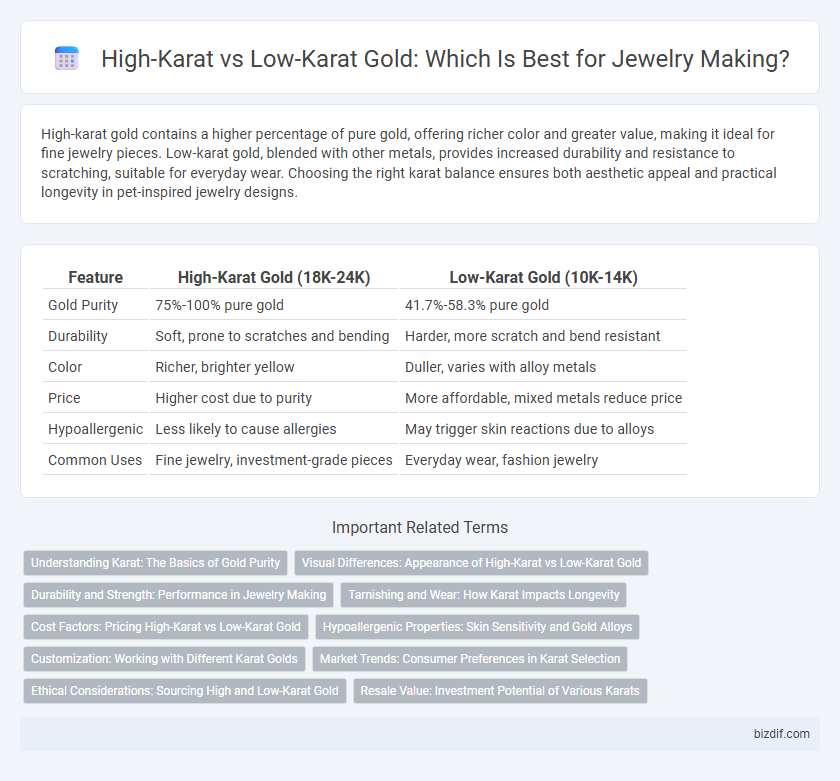High-karat gold contains a higher percentage of pure gold, offering richer color and greater value, making it ideal for fine jewelry pieces. Low-karat gold, blended with other metals, provides increased durability and resistance to scratching, suitable for everyday wear. Choosing the right karat balance ensures both aesthetic appeal and practical longevity in pet-inspired jewelry designs.
Table of Comparison
| Feature | High-Karat Gold (18K-24K) | Low-Karat Gold (10K-14K) |
|---|---|---|
| Gold Purity | 75%-100% pure gold | 41.7%-58.3% pure gold |
| Durability | Soft, prone to scratches and bending | Harder, more scratch and bend resistant |
| Color | Richer, brighter yellow | Duller, varies with alloy metals |
| Price | Higher cost due to purity | More affordable, mixed metals reduce price |
| Hypoallergenic | Less likely to cause allergies | May trigger skin reactions due to alloys |
| Common Uses | Fine jewelry, investment-grade pieces | Everyday wear, fashion jewelry |
Understanding Karat: The Basics of Gold Purity
High-karat gold, typically 18K and above, contains a higher percentage of pure gold, offering greater luster and natural resistance to tarnish, making it ideal for fine jewelry. Low-karat gold, such as 10K or 14K, incorporates more alloy metals like silver or copper, enhancing durability and affordability but slightly reducing gold's natural softness and brightness. Understanding karat values is essential for choosing jewelry that balances purity, strength, and cost according to personal preferences and usage.
Visual Differences: Appearance of High-Karat vs Low-Karat Gold
High-karat gold features a rich, deep yellow hue due to its higher purity, typically 18K or above, which appeals to those seeking a vibrant and classic gold appearance. Low-karat gold, such as 10K or 14K, displays a paler, subtler yellow tone because it is alloyed with metals like copper, silver, or zinc, enhancing durability but diminishing the intense gold color. These visual differences influence jewelry choice, balancing aesthetic appeal with hardness and price considerations.
Durability and Strength: Performance in Jewelry Making
High-karat gold, typically 18K or above, contains a higher percentage of pure gold, resulting in a softer and more malleable metal that is prone to scratches and deformation in everyday wear. Low-karat gold, such as 10K or 14K, incorporates a greater proportion of alloy metals like copper, silver, and zinc, significantly enhancing its durability and resistance to bending or damage, making it highly suitable for rings and bracelets subjected to frequent impact. Jewelry makers often prefer low-karat gold for pieces requiring structural integrity and long-lasting wearability without compromising aesthetic appeal.
Tarnishing and Wear: How Karat Impacts Longevity
High-karat gold, containing a higher percentage of pure gold, resists tarnishing and corrosion better than low-karat gold due to its minimal alloy content. Low-karat gold alloys metals such as copper and silver, which can oxidize over time, leading to faster tarnishing and visible wear. Choosing high-karat gold enhances the longevity and maintains the luster of jewelry, making it ideal for pieces exposed to frequent wear or moisture.
Cost Factors: Pricing High-Karat vs Low-Karat Gold
High-karat gold, typically 18K or above, commands higher prices due to its greater purity and rich yellow hue, which appeals to premium jewelry buyers. Low-karat gold, such as 10K or 14K, contains more alloy metals, reducing cost and enhancing durability, making it a budget-friendly choice for everyday wear. Pricing differences are influenced by market gold rates, alloy composition, and manufacturing complexity, affecting overall jewelry value.
Hypoallergenic Properties: Skin Sensitivity and Gold Alloys
High-karat gold, containing a higher percentage of pure gold, is less likely to cause skin irritation due to its lower content of allergenic metal alloys like nickel and copper. Low-karat gold, which combines gold with a greater proportion of other metals, often triggers allergic reactions in individuals with sensitive skin. Selecting high-karat gold jewelry is essential for minimizing hypersensitivity and ensuring hypoallergenic properties.
Customization: Working with Different Karat Golds
High-karat gold, such as 18K or 24K, offers superior malleability and a richer color, making it ideal for intricate jewelry designs and detailed customization. Low-karat gold alloys, like 10K or 14K, provide increased durability and a broader range of color variations due to the higher presence of other metals, which is advantageous for everyday wear pieces. Jewelers must carefully select the karat based on the desired balance between design complexity, wearability, and customization options.
Market Trends: Consumer Preferences in Karat Selection
High-karat gold, prized for its rich color and purity, continues to attract luxury buyers seeking premium jewelry, driving market demand in regions valuing investment-grade pieces. Low-karat gold, favored for its affordability and durability, appeals to cost-conscious consumers and trends in fashion-forward, everyday wear. Market data indicates a growing preference for mid-range karats like 14K and 18K, balancing the allure of gold's purity with practical considerations of strength and price.
Ethical Considerations: Sourcing High and Low-Karat Gold
High-karat gold, typically 18K and above, is often sourced with greater emphasis on ethical mining practices to minimize environmental impact and support fair labor conditions. Low-karat gold, such as 10K or 14K, may involve higher amounts of alloy metals that can obscure the traceability and ethical sourcing of the gold used. Consumers increasingly prioritize transparent supply chains and certification standards like Fairtrade and Responsible Jewellery Council (RJC) to ensure both high- and low-karat gold meet ethical sourcing criteria in jewelry making.
Resale Value: Investment Potential of Various Karats
High-karat gold, such as 18K and 24K, commands higher resale value due to its purity and rarity, making it a preferred investment in the jewelry market. Low-karat gold, like 10K or 14K, contains more alloy metals which reduce its gold content and resale potential, but it offers greater durability for daily wear. Investors prioritize high-karat gold pieces to maximize long-term value and liquidity in fluctuating gold markets.
High-karat gold vs low-karat gold Infographic

 bizdif.com
bizdif.com